How Teaching Styles Affect Depression: A Literature Review Analysis
VerifiedAdded on 2023/04/20
|8
|2122
|391
Report
AI Summary
This literature review investigates the impact of teaching styles on the behavior of international students, specifically focusing on the hopelessness theory of depression. The review analyzes three articles that explore the connection between teaching methods and students' mental well-being. It examines how teaching styles can influence students' attributions of negative events, leading to feelings of hopelessness and potentially depression. The review highlights the importance of teachers creating engaging and supportive learning environments. It also discusses the role of optimism and pessimism in relation to depression, emphasizing how positive and negative experiences can affect students' mental states. The review aims to provide insights into how educators can modify their teaching approaches to promote a more positive learning experience for students, especially those at risk of depression. The report emphasizes the importance of understanding how teaching styles can either exacerbate or mitigate feelings of hopelessness and ultimately impact the learning process.

Running head: TEACHING STYLES AND HOPELESSNESS THEORY OF DEPRESSION 1
How Teaching Style Effect on Behavior of International Students
Name
Professor
Course
Date
How Teaching Style Effect on Behavior of International Students
Name
Professor
Course
Date
Paraphrase This Document
Need a fresh take? Get an instant paraphrase of this document with our AI Paraphraser
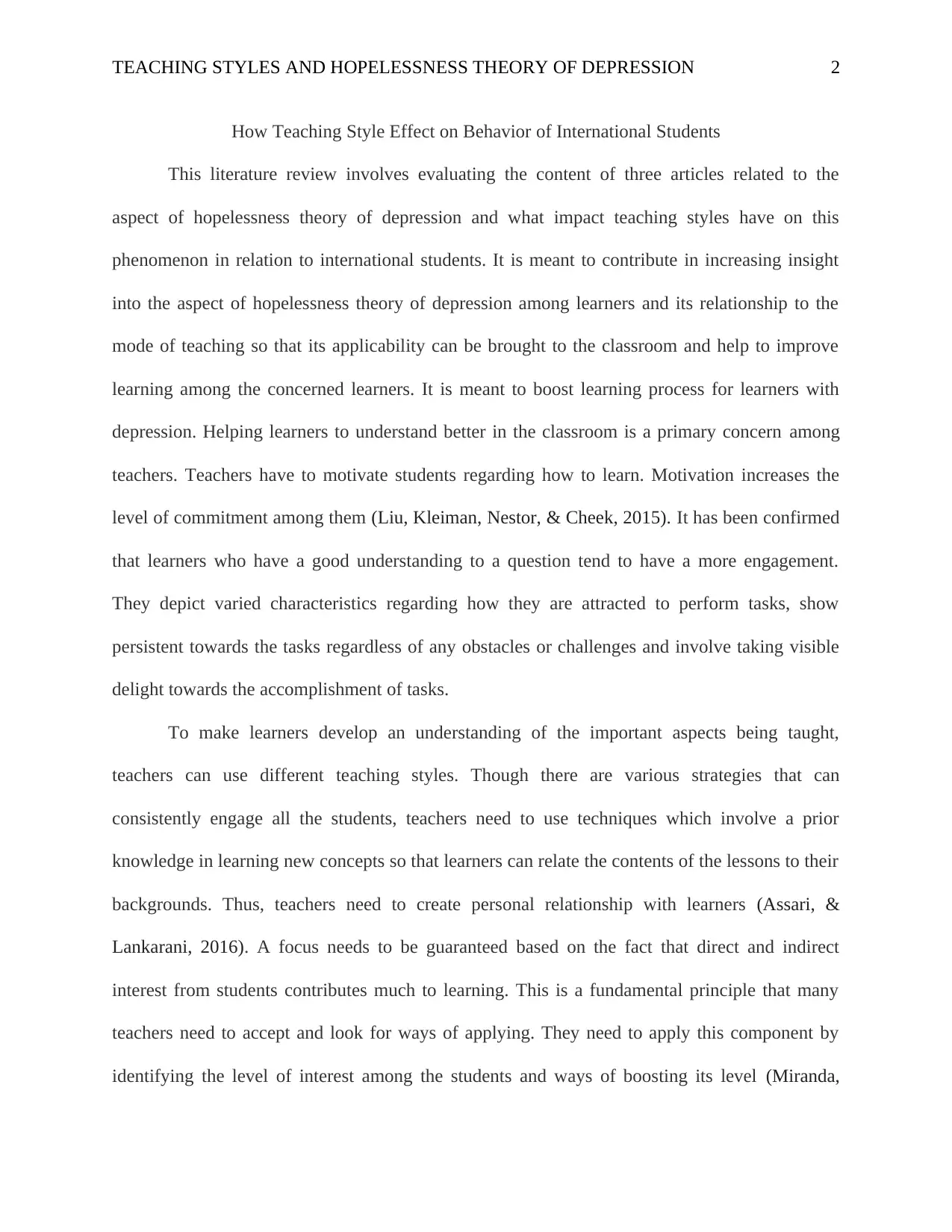
TEACHING STYLES AND HOPELESSNESS THEORY OF DEPRESSION 2
How Teaching Style Effect on Behavior of International Students
This literature review involves evaluating the content of three articles related to the
aspect of hopelessness theory of depression and what impact teaching styles have on this
phenomenon in relation to international students. It is meant to contribute in increasing insight
into the aspect of hopelessness theory of depression among learners and its relationship to the
mode of teaching so that its applicability can be brought to the classroom and help to improve
learning among the concerned learners. It is meant to boost learning process for learners with
depression. Helping learners to understand better in the classroom is a primary concern among
teachers. Teachers have to motivate students regarding how to learn. Motivation increases the
level of commitment among them (Liu, Kleiman, Nestor, & Cheek, 2015). It has been confirmed
that learners who have a good understanding to a question tend to have a more engagement.
They depict varied characteristics regarding how they are attracted to perform tasks, show
persistent towards the tasks regardless of any obstacles or challenges and involve taking visible
delight towards the accomplishment of tasks.
To make learners develop an understanding of the important aspects being taught,
teachers can use different teaching styles. Though there are various strategies that can
consistently engage all the students, teachers need to use techniques which involve a prior
knowledge in learning new concepts so that learners can relate the contents of the lessons to their
backgrounds. Thus, teachers need to create personal relationship with learners (Assari, &
Lankarani, 2016). A focus needs to be guaranteed based on the fact that direct and indirect
interest from students contributes much to learning. This is a fundamental principle that many
teachers need to accept and look for ways of applying. They need to apply this component by
identifying the level of interest among the students and ways of boosting its level (Miranda,
How Teaching Style Effect on Behavior of International Students
This literature review involves evaluating the content of three articles related to the
aspect of hopelessness theory of depression and what impact teaching styles have on this
phenomenon in relation to international students. It is meant to contribute in increasing insight
into the aspect of hopelessness theory of depression among learners and its relationship to the
mode of teaching so that its applicability can be brought to the classroom and help to improve
learning among the concerned learners. It is meant to boost learning process for learners with
depression. Helping learners to understand better in the classroom is a primary concern among
teachers. Teachers have to motivate students regarding how to learn. Motivation increases the
level of commitment among them (Liu, Kleiman, Nestor, & Cheek, 2015). It has been confirmed
that learners who have a good understanding to a question tend to have a more engagement.
They depict varied characteristics regarding how they are attracted to perform tasks, show
persistent towards the tasks regardless of any obstacles or challenges and involve taking visible
delight towards the accomplishment of tasks.
To make learners develop an understanding of the important aspects being taught,
teachers can use different teaching styles. Though there are various strategies that can
consistently engage all the students, teachers need to use techniques which involve a prior
knowledge in learning new concepts so that learners can relate the contents of the lessons to their
backgrounds. Thus, teachers need to create personal relationship with learners (Assari, &
Lankarani, 2016). A focus needs to be guaranteed based on the fact that direct and indirect
interest from students contributes much to learning. This is a fundamental principle that many
teachers need to accept and look for ways of applying. They need to apply this component by
identifying the level of interest among the students and ways of boosting its level (Miranda,
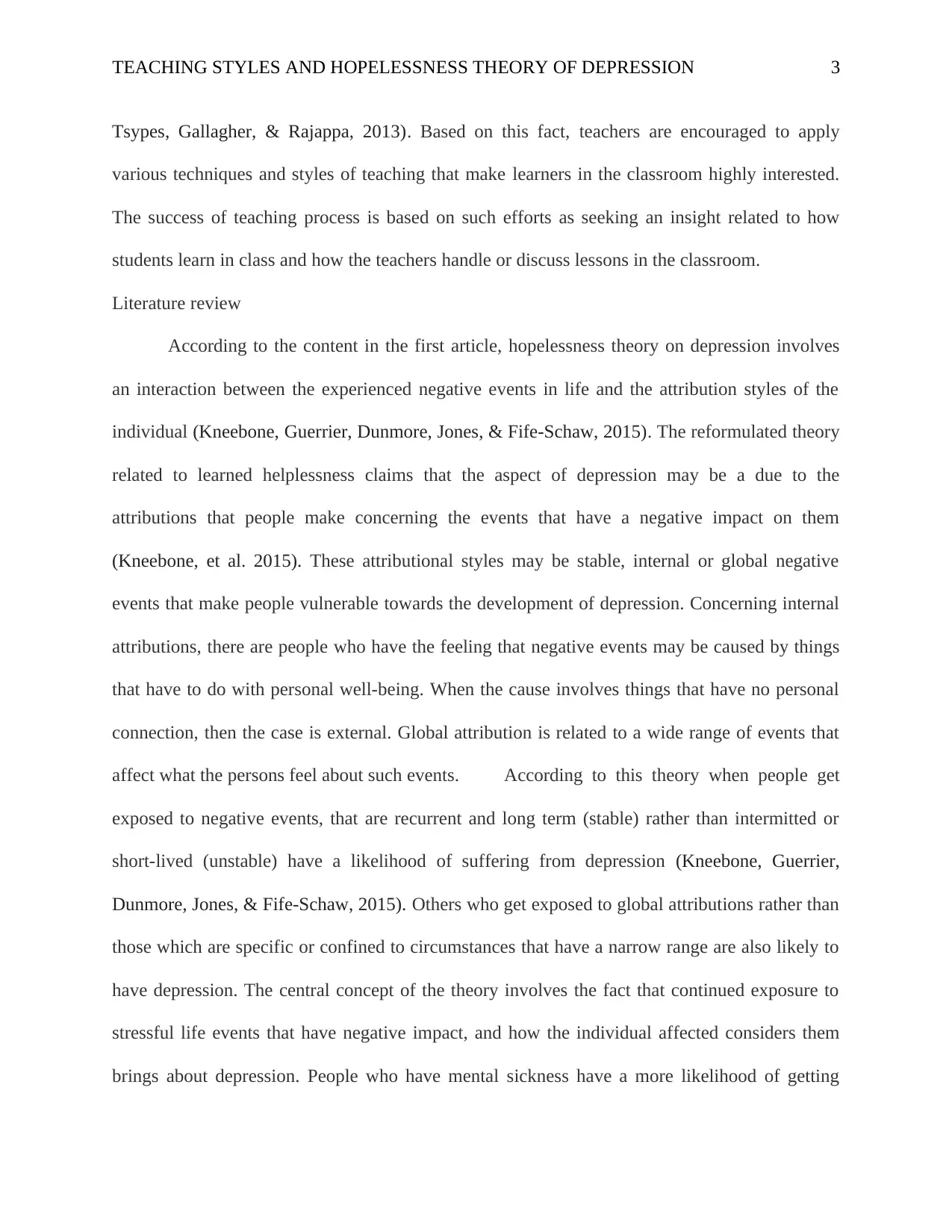
TEACHING STYLES AND HOPELESSNESS THEORY OF DEPRESSION 3
Tsypes, Gallagher, & Rajappa, 2013). Based on this fact, teachers are encouraged to apply
various techniques and styles of teaching that make learners in the classroom highly interested.
The success of teaching process is based on such efforts as seeking an insight related to how
students learn in class and how the teachers handle or discuss lessons in the classroom.
Literature review
According to the content in the first article, hopelessness theory on depression involves
an interaction between the experienced negative events in life and the attribution styles of the
individual (Kneebone, Guerrier, Dunmore, Jones, & Fife-Schaw, 2015). The reformulated theory
related to learned helplessness claims that the aspect of depression may be a due to the
attributions that people make concerning the events that have a negative impact on them
(Kneebone, et al. 2015). These attributional styles may be stable, internal or global negative
events that make people vulnerable towards the development of depression. Concerning internal
attributions, there are people who have the feeling that negative events may be caused by things
that have to do with personal well-being. When the cause involves things that have no personal
connection, then the case is external. Global attribution is related to a wide range of events that
affect what the persons feel about such events. According to this theory when people get
exposed to negative events, that are recurrent and long term (stable) rather than intermitted or
short-lived (unstable) have a likelihood of suffering from depression (Kneebone, Guerrier,
Dunmore, Jones, & Fife-Schaw, 2015). Others who get exposed to global attributions rather than
those which are specific or confined to circumstances that have a narrow range are also likely to
have depression. The central concept of the theory involves the fact that continued exposure to
stressful life events that have negative impact, and how the individual affected considers them
brings about depression. People who have mental sickness have a more likelihood of getting
Tsypes, Gallagher, & Rajappa, 2013). Based on this fact, teachers are encouraged to apply
various techniques and styles of teaching that make learners in the classroom highly interested.
The success of teaching process is based on such efforts as seeking an insight related to how
students learn in class and how the teachers handle or discuss lessons in the classroom.
Literature review
According to the content in the first article, hopelessness theory on depression involves
an interaction between the experienced negative events in life and the attribution styles of the
individual (Kneebone, Guerrier, Dunmore, Jones, & Fife-Schaw, 2015). The reformulated theory
related to learned helplessness claims that the aspect of depression may be a due to the
attributions that people make concerning the events that have a negative impact on them
(Kneebone, et al. 2015). These attributional styles may be stable, internal or global negative
events that make people vulnerable towards the development of depression. Concerning internal
attributions, there are people who have the feeling that negative events may be caused by things
that have to do with personal well-being. When the cause involves things that have no personal
connection, then the case is external. Global attribution is related to a wide range of events that
affect what the persons feel about such events. According to this theory when people get
exposed to negative events, that are recurrent and long term (stable) rather than intermitted or
short-lived (unstable) have a likelihood of suffering from depression (Kneebone, Guerrier,
Dunmore, Jones, & Fife-Schaw, 2015). Others who get exposed to global attributions rather than
those which are specific or confined to circumstances that have a narrow range are also likely to
have depression. The central concept of the theory involves the fact that continued exposure to
stressful life events that have negative impact, and how the individual affected considers them
brings about depression. People who have mental sickness have a more likelihood of getting
⊘ This is a preview!⊘
Do you want full access?
Subscribe today to unlock all pages.

Trusted by 1+ million students worldwide
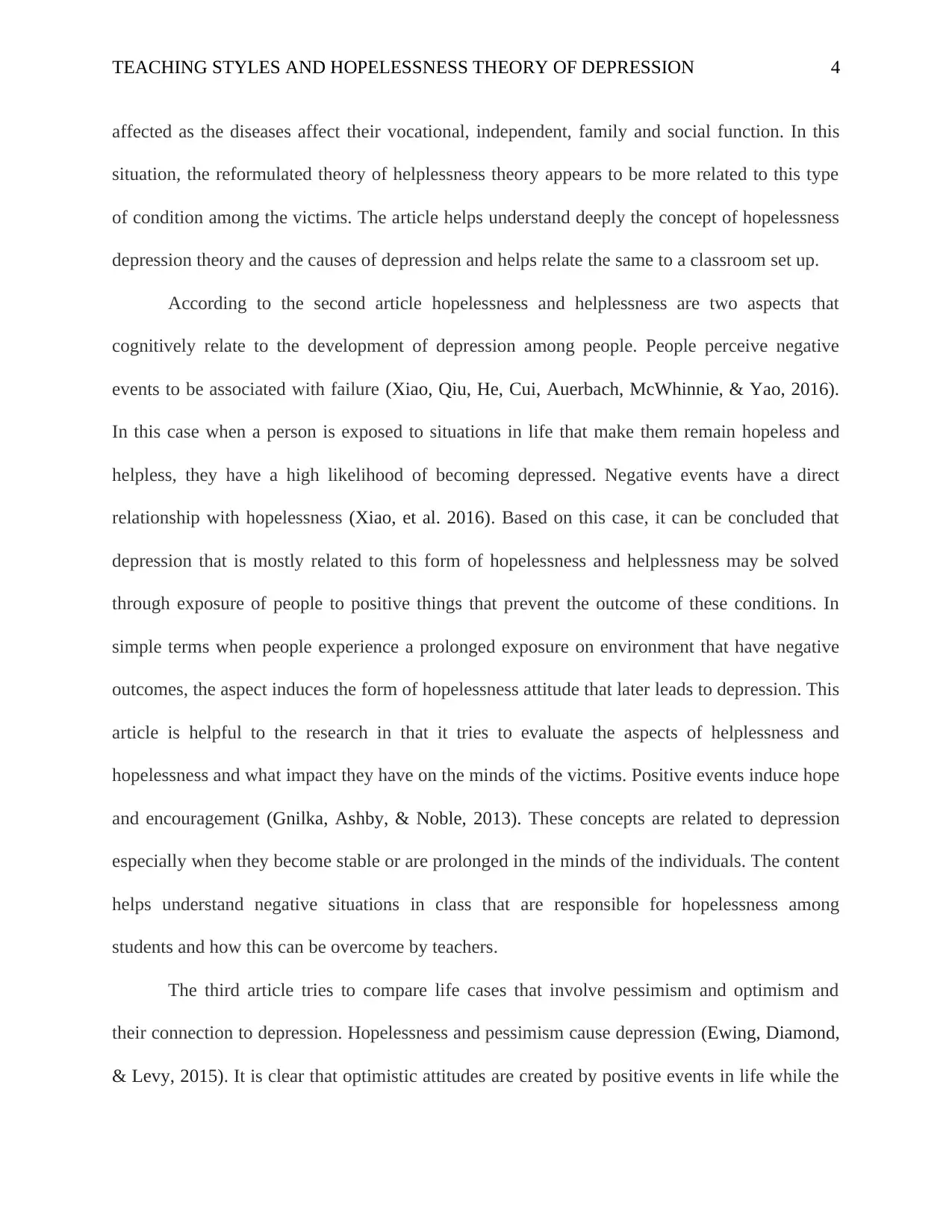
TEACHING STYLES AND HOPELESSNESS THEORY OF DEPRESSION 4
affected as the diseases affect their vocational, independent, family and social function. In this
situation, the reformulated theory of helplessness theory appears to be more related to this type
of condition among the victims. The article helps understand deeply the concept of hopelessness
depression theory and the causes of depression and helps relate the same to a classroom set up.
According to the second article hopelessness and helplessness are two aspects that
cognitively relate to the development of depression among people. People perceive negative
events to be associated with failure (Xiao, Qiu, He, Cui, Auerbach, McWhinnie, & Yao, 2016).
In this case when a person is exposed to situations in life that make them remain hopeless and
helpless, they have a high likelihood of becoming depressed. Negative events have a direct
relationship with hopelessness (Xiao, et al. 2016). Based on this case, it can be concluded that
depression that is mostly related to this form of hopelessness and helplessness may be solved
through exposure of people to positive things that prevent the outcome of these conditions. In
simple terms when people experience a prolonged exposure on environment that have negative
outcomes, the aspect induces the form of hopelessness attitude that later leads to depression. This
article is helpful to the research in that it tries to evaluate the aspects of helplessness and
hopelessness and what impact they have on the minds of the victims. Positive events induce hope
and encouragement (Gnilka, Ashby, & Noble, 2013). These concepts are related to depression
especially when they become stable or are prolonged in the minds of the individuals. The content
helps understand negative situations in class that are responsible for hopelessness among
students and how this can be overcome by teachers.
The third article tries to compare life cases that involve pessimism and optimism and
their connection to depression. Hopelessness and pessimism cause depression (Ewing, Diamond,
& Levy, 2015). It is clear that optimistic attitudes are created by positive events in life while the
affected as the diseases affect their vocational, independent, family and social function. In this
situation, the reformulated theory of helplessness theory appears to be more related to this type
of condition among the victims. The article helps understand deeply the concept of hopelessness
depression theory and the causes of depression and helps relate the same to a classroom set up.
According to the second article hopelessness and helplessness are two aspects that
cognitively relate to the development of depression among people. People perceive negative
events to be associated with failure (Xiao, Qiu, He, Cui, Auerbach, McWhinnie, & Yao, 2016).
In this case when a person is exposed to situations in life that make them remain hopeless and
helpless, they have a high likelihood of becoming depressed. Negative events have a direct
relationship with hopelessness (Xiao, et al. 2016). Based on this case, it can be concluded that
depression that is mostly related to this form of hopelessness and helplessness may be solved
through exposure of people to positive things that prevent the outcome of these conditions. In
simple terms when people experience a prolonged exposure on environment that have negative
outcomes, the aspect induces the form of hopelessness attitude that later leads to depression. This
article is helpful to the research in that it tries to evaluate the aspects of helplessness and
hopelessness and what impact they have on the minds of the victims. Positive events induce hope
and encouragement (Gnilka, Ashby, & Noble, 2013). These concepts are related to depression
especially when they become stable or are prolonged in the minds of the individuals. The content
helps understand negative situations in class that are responsible for hopelessness among
students and how this can be overcome by teachers.
The third article tries to compare life cases that involve pessimism and optimism and
their connection to depression. Hopelessness and pessimism cause depression (Ewing, Diamond,
& Levy, 2015). It is clear that optimistic attitudes are created by positive events in life while the
Paraphrase This Document
Need a fresh take? Get an instant paraphrase of this document with our AI Paraphraser
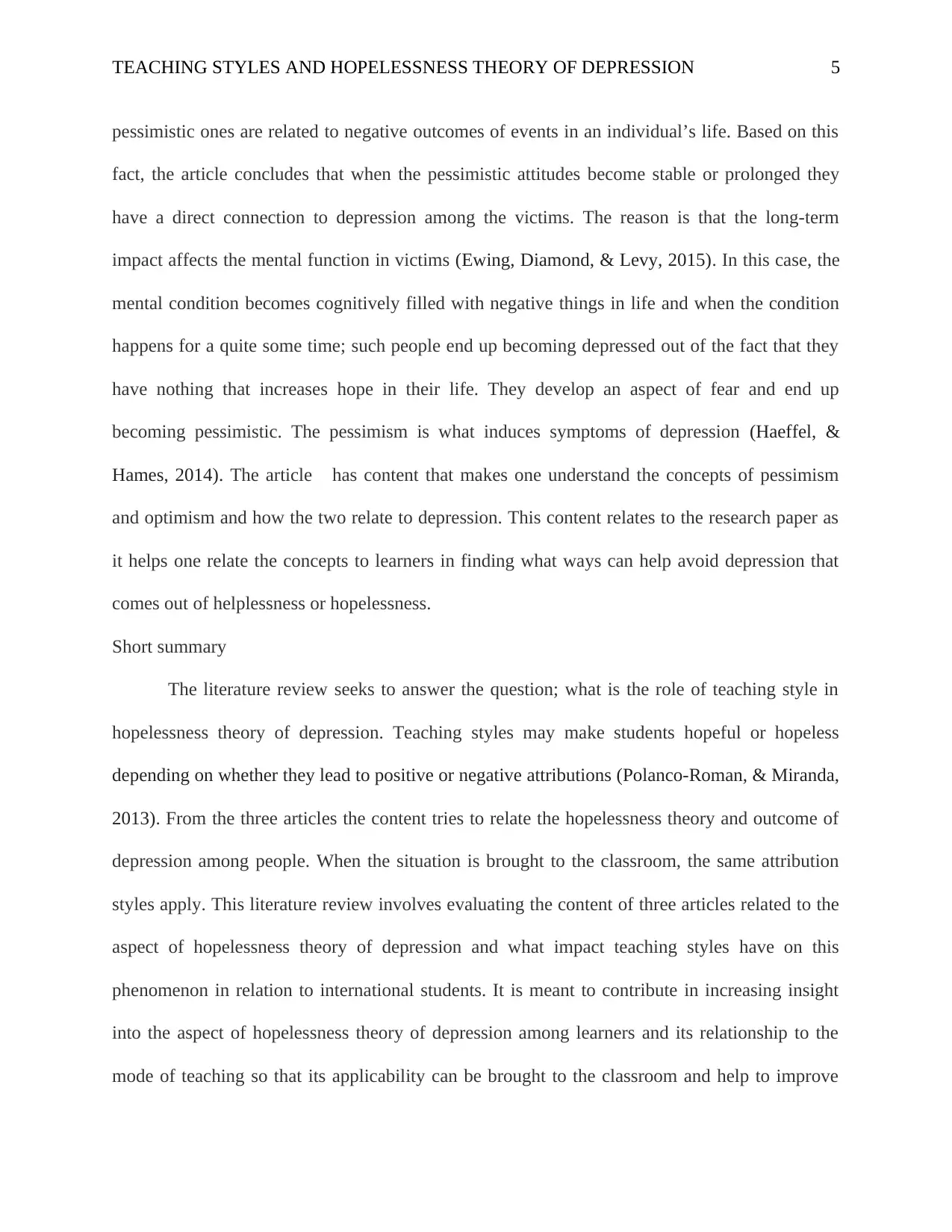
TEACHING STYLES AND HOPELESSNESS THEORY OF DEPRESSION 5
pessimistic ones are related to negative outcomes of events in an individual’s life. Based on this
fact, the article concludes that when the pessimistic attitudes become stable or prolonged they
have a direct connection to depression among the victims. The reason is that the long-term
impact affects the mental function in victims (Ewing, Diamond, & Levy, 2015). In this case, the
mental condition becomes cognitively filled with negative things in life and when the condition
happens for a quite some time; such people end up becoming depressed out of the fact that they
have nothing that increases hope in their life. They develop an aspect of fear and end up
becoming pessimistic. The pessimism is what induces symptoms of depression (Haeffel, &
Hames, 2014). The article has content that makes one understand the concepts of pessimism
and optimism and how the two relate to depression. This content relates to the research paper as
it helps one relate the concepts to learners in finding what ways can help avoid depression that
comes out of helplessness or hopelessness.
Short summary
The literature review seeks to answer the question; what is the role of teaching style in
hopelessness theory of depression. Teaching styles may make students hopeful or hopeless
depending on whether they lead to positive or negative attributions (Polanco-Roman, & Miranda,
2013). From the three articles the content tries to relate the hopelessness theory and outcome of
depression among people. When the situation is brought to the classroom, the same attribution
styles apply. This literature review involves evaluating the content of three articles related to the
aspect of hopelessness theory of depression and what impact teaching styles have on this
phenomenon in relation to international students. It is meant to contribute in increasing insight
into the aspect of hopelessness theory of depression among learners and its relationship to the
mode of teaching so that its applicability can be brought to the classroom and help to improve
pessimistic ones are related to negative outcomes of events in an individual’s life. Based on this
fact, the article concludes that when the pessimistic attitudes become stable or prolonged they
have a direct connection to depression among the victims. The reason is that the long-term
impact affects the mental function in victims (Ewing, Diamond, & Levy, 2015). In this case, the
mental condition becomes cognitively filled with negative things in life and when the condition
happens for a quite some time; such people end up becoming depressed out of the fact that they
have nothing that increases hope in their life. They develop an aspect of fear and end up
becoming pessimistic. The pessimism is what induces symptoms of depression (Haeffel, &
Hames, 2014). The article has content that makes one understand the concepts of pessimism
and optimism and how the two relate to depression. This content relates to the research paper as
it helps one relate the concepts to learners in finding what ways can help avoid depression that
comes out of helplessness or hopelessness.
Short summary
The literature review seeks to answer the question; what is the role of teaching style in
hopelessness theory of depression. Teaching styles may make students hopeful or hopeless
depending on whether they lead to positive or negative attributions (Polanco-Roman, & Miranda,
2013). From the three articles the content tries to relate the hopelessness theory and outcome of
depression among people. When the situation is brought to the classroom, the same attribution
styles apply. This literature review involves evaluating the content of three articles related to the
aspect of hopelessness theory of depression and what impact teaching styles have on this
phenomenon in relation to international students. It is meant to contribute in increasing insight
into the aspect of hopelessness theory of depression among learners and its relationship to the
mode of teaching so that its applicability can be brought to the classroom and help to improve

TEACHING STYLES AND HOPELESSNESS THEORY OF DEPRESSION 6
learning among the concerned learners. It is meant to boost learning process for learners with
depression. Helping learners to understand better in the classroom is a primary concern in every
teacher. Teachers have to motivate students regarding how to learn. Motivated learning leads to
increased performance among learners (Reivich, Gillham, Chaplin, & Seligman, 2013). It has
been confirmed that learners who have a good understanding to a question tend to have a more
engagement. They depict varied characteristics regarding how they are attracted to perform tasks,
show persistent towards the tasks regardless of any obstacles or challenges and involve taking
visible delight towards the accomplishment of tasks.
learning among the concerned learners. It is meant to boost learning process for learners with
depression. Helping learners to understand better in the classroom is a primary concern in every
teacher. Teachers have to motivate students regarding how to learn. Motivated learning leads to
increased performance among learners (Reivich, Gillham, Chaplin, & Seligman, 2013). It has
been confirmed that learners who have a good understanding to a question tend to have a more
engagement. They depict varied characteristics regarding how they are attracted to perform tasks,
show persistent towards the tasks regardless of any obstacles or challenges and involve taking
visible delight towards the accomplishment of tasks.
⊘ This is a preview!⊘
Do you want full access?
Subscribe today to unlock all pages.

Trusted by 1+ million students worldwide

TEACHING STYLES AND HOPELESSNESS THEORY OF DEPRESSION 7
References
Assari, S., & Lankarani, M. M. (2016). Depressive symptoms are associated with more
hopelessness among white than black older adults. Frontiers in public health, 4, 82.
Ewing, E. S. K., Diamond, G., & Levy, S. (2015). Attachment-based family therapy for
depressed and suicidal adolescents: Theory, clinical model and empirical
support. Attachment & human development, 17(2), 136-156.
Gnilka, P. B., Ashby, J. S., & Noble, C. M. (2013). Adaptive and maladaptive perfectionism as
mediators of adult attachment styles and depression, hopelessness, and life
satisfaction. Journal of Counseling & Development, 91(1), 78-86.
Haeffel, G. J., & Hames, J. L. (2014). Cognitive vulnerability to depression can be
contagious. Clinical Psychological Science, 2(1), 75-85.
Kleiman, E. M., Law, K. C., & Anestis, M. D. (2014). Do theories of suicide play well together?
Integrating components of the hopelessness and interpersonal psychological theories of
suicide. Comprehensive psychiatry, 55(3), 431-438.
Liu, R. T., Kleiman, E. M., Nestor, B. A., & Cheek, S. M. (2015). The hopelessness theory of
depression: A quarter‐century in review. Clinical Psychology: Science and
Practice, 22(4), 345-365.
Miranda, R., Tsypes, A., Gallagher, M., & Rajappa, K. (2013). Rumination and hopelessness as
mediators of the relation between perceived emotion dysregulation and suicidal
ideation. Cognitive Therapy and Research, 37(4), 786-795.
Polanco-Roman, L., & Miranda, R. (2013). Culturally related stress, hopelessness, and
vulnerability to depressive symptoms and suicidal ideation in emerging
adulthood. Behavior therapy, 44(1), 75-87.
References
Assari, S., & Lankarani, M. M. (2016). Depressive symptoms are associated with more
hopelessness among white than black older adults. Frontiers in public health, 4, 82.
Ewing, E. S. K., Diamond, G., & Levy, S. (2015). Attachment-based family therapy for
depressed and suicidal adolescents: Theory, clinical model and empirical
support. Attachment & human development, 17(2), 136-156.
Gnilka, P. B., Ashby, J. S., & Noble, C. M. (2013). Adaptive and maladaptive perfectionism as
mediators of adult attachment styles and depression, hopelessness, and life
satisfaction. Journal of Counseling & Development, 91(1), 78-86.
Haeffel, G. J., & Hames, J. L. (2014). Cognitive vulnerability to depression can be
contagious. Clinical Psychological Science, 2(1), 75-85.
Kleiman, E. M., Law, K. C., & Anestis, M. D. (2014). Do theories of suicide play well together?
Integrating components of the hopelessness and interpersonal psychological theories of
suicide. Comprehensive psychiatry, 55(3), 431-438.
Liu, R. T., Kleiman, E. M., Nestor, B. A., & Cheek, S. M. (2015). The hopelessness theory of
depression: A quarter‐century in review. Clinical Psychology: Science and
Practice, 22(4), 345-365.
Miranda, R., Tsypes, A., Gallagher, M., & Rajappa, K. (2013). Rumination and hopelessness as
mediators of the relation between perceived emotion dysregulation and suicidal
ideation. Cognitive Therapy and Research, 37(4), 786-795.
Polanco-Roman, L., & Miranda, R. (2013). Culturally related stress, hopelessness, and
vulnerability to depressive symptoms and suicidal ideation in emerging
adulthood. Behavior therapy, 44(1), 75-87.
Paraphrase This Document
Need a fresh take? Get an instant paraphrase of this document with our AI Paraphraser
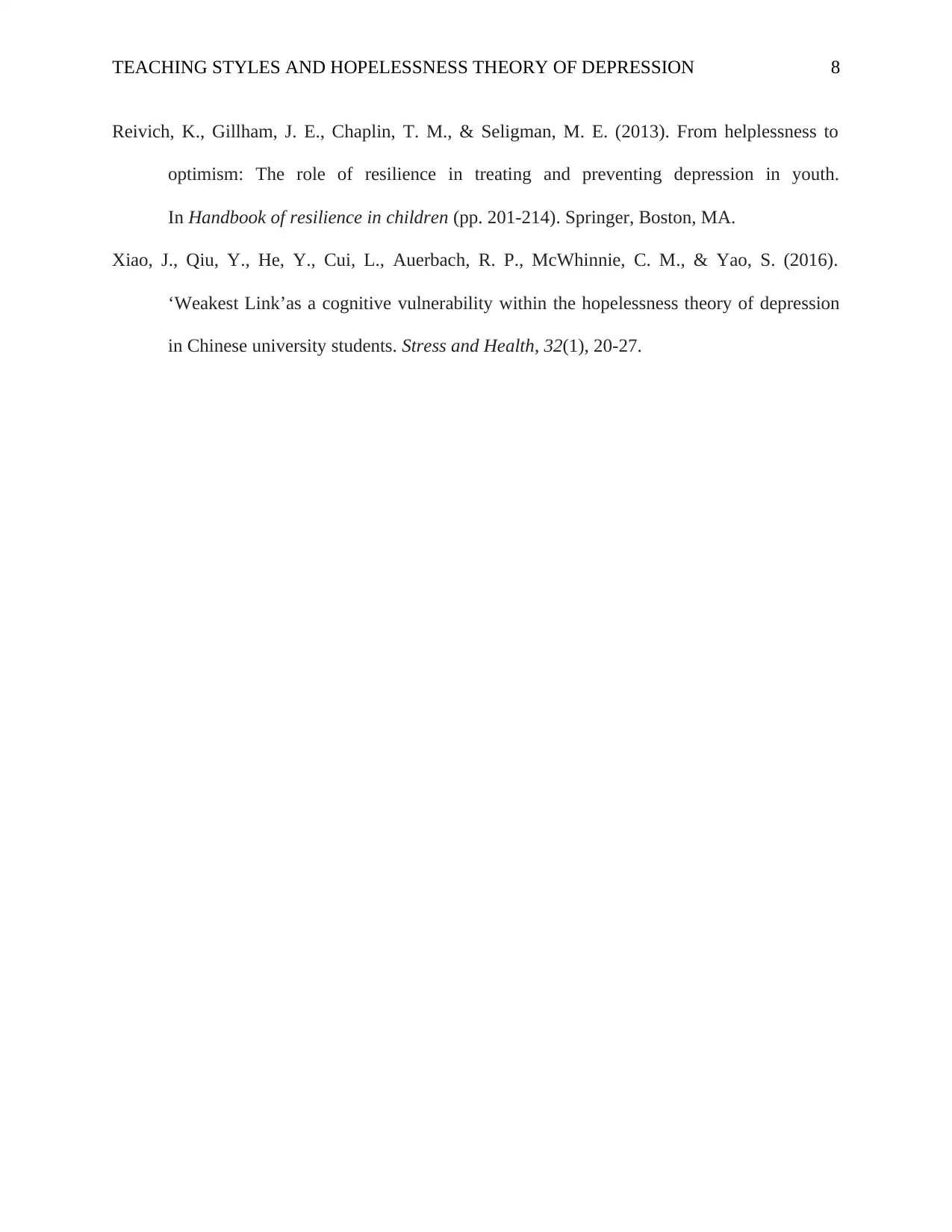
TEACHING STYLES AND HOPELESSNESS THEORY OF DEPRESSION 8
Reivich, K., Gillham, J. E., Chaplin, T. M., & Seligman, M. E. (2013). From helplessness to
optimism: The role of resilience in treating and preventing depression in youth.
In Handbook of resilience in children (pp. 201-214). Springer, Boston, MA.
Xiao, J., Qiu, Y., He, Y., Cui, L., Auerbach, R. P., McWhinnie, C. M., & Yao, S. (2016).
‘Weakest Link’as a cognitive vulnerability within the hopelessness theory of depression
in Chinese university students. Stress and Health, 32(1), 20-27.
Reivich, K., Gillham, J. E., Chaplin, T. M., & Seligman, M. E. (2013). From helplessness to
optimism: The role of resilience in treating and preventing depression in youth.
In Handbook of resilience in children (pp. 201-214). Springer, Boston, MA.
Xiao, J., Qiu, Y., He, Y., Cui, L., Auerbach, R. P., McWhinnie, C. M., & Yao, S. (2016).
‘Weakest Link’as a cognitive vulnerability within the hopelessness theory of depression
in Chinese university students. Stress and Health, 32(1), 20-27.
1 out of 8
Related Documents
Your All-in-One AI-Powered Toolkit for Academic Success.
+13062052269
info@desklib.com
Available 24*7 on WhatsApp / Email
![[object Object]](/_next/static/media/star-bottom.7253800d.svg)
Unlock your academic potential
Copyright © 2020–2025 A2Z Services. All Rights Reserved. Developed and managed by ZUCOL.





